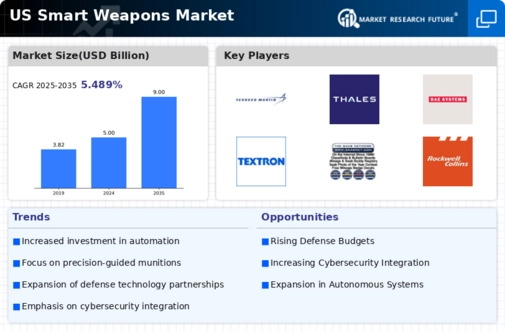Geopolitical Tensions
Geopolitical tensions continue to be a significant driver for the smart weapons market. The ongoing conflicts and strategic rivalries, particularly involving nations such as China and Russia, have prompted the US to bolster its defense capabilities. The smart weapons market is likely to see increased demand as military planners seek advanced solutions to counter potential threats. The US military's focus on deterrence strategies necessitates the acquisition of sophisticated weaponry that can operate effectively in contested environments. As a result, the market is projected to grow, with estimates suggesting a compound annual growth rate (CAGR) of 5.5% through 2030. This growth reflects the urgency to maintain technological superiority and readiness in an increasingly complex global security landscape.
Collaborative Defense Programs
Collaborative defense programs are emerging as a vital driver for the smart weapons market. The US military's partnerships with allied nations aim to enhance collective security and interoperability. These collaborations often involve joint development and procurement of advanced weapon systems, including smart weapons. The smart weapons market is poised to benefit from these initiatives, as they promote shared technological advancements and cost efficiencies. For instance, the US has engaged in several cooperative agreements with NATO allies, focusing on the development of next-generation munitions. Such partnerships not only expand the market reach but also facilitate the exchange of innovative ideas and technologies, potentially leading to a more robust and competitive smart weapons market.
Emerging Military Technologies
The integration of emerging military technologies is a pivotal driver for the smart weapons market. Innovations in artificial intelligence, machine learning, and advanced robotics are reshaping the landscape of modern warfare. The US Department of Defense has allocated substantial funding, estimated at $700 billion for 2025, to enhance military capabilities through these technologies. This investment is likely to accelerate the development and deployment of smart weapons, which are designed to improve precision and reduce collateral damage. As military operations become increasingly reliant on technology, the demand for smart weapons is expected to rise, thereby propelling the market forward. The smart weapons market is thus positioned to benefit from these advancements, as they promise to enhance operational effectiveness and strategic advantages in combat scenarios.
Defense Modernization Initiatives
Defense modernization initiatives are driving the evolution of the smart weapons market. The US government has recognized the necessity of updating its military arsenal to address contemporary threats. This modernization effort includes the integration of smart weapons that enhance operational capabilities and ensure readiness. The smart weapons market is likely to benefit from these initiatives, as they align with the military's strategic goals of maintaining technological superiority. With an estimated $50 billion earmarked for modernization projects in 2025, the demand for advanced weaponry is anticipated to rise. This investment not only supports the development of new systems but also facilitates upgrades to existing platforms, thereby fostering growth within the smart weapons market.
Increased Focus on Precision Warfare
The shift towards precision warfare is a crucial driver for the smart weapons market. The US military's emphasis on minimizing collateral damage while maximizing operational effectiveness has led to a growing reliance on smart weapons. These systems, which utilize advanced guidance technologies, are designed to strike targets with high accuracy. The smart weapons market is experiencing a surge in demand as military operations increasingly prioritize precision over sheer firepower. This trend is underscored by the US military's investment in precision-guided munitions, which accounted for approximately $10 billion in procurement in 2025. As the need for effective and ethical military solutions becomes more pronounced, the market for smart weapons is expected to expand significantly.





















Leave a Comment